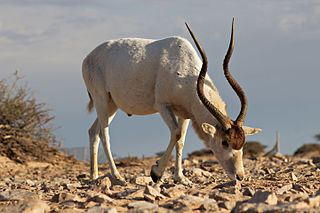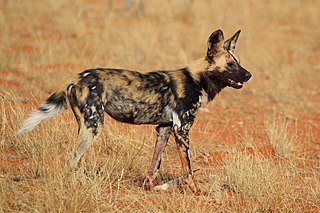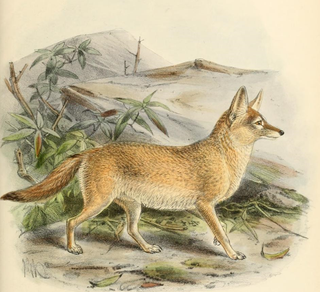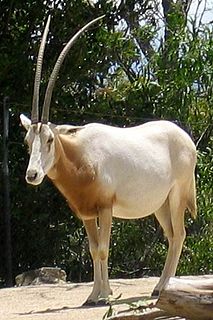 W
WThe addax, also known as the white antelope and the screwhorn antelope, is an antelope of the genus Addax, that lives in the Sahara Desert. It was first described scientifically by Henri de Blainville in 1816. As suggested by its alternative name, this pale antelope has long, twisted horns - typically 55 to 80 cm in females and 70 to 85 cm in males. Males stand from 105 to 115 cm at the shoulder, with females at 95 to 110 cm. They are sexually dimorphic, as the females are smaller than the males. The colour of the coat depends on the season - in the winter, it is greyish-brown with white hindquarters and legs, and long, brown hair on the head, neck, and shoulders; in the summer, the coat turns almost completely white or sandy blonde.
 W
WApis mellifera sahariensis is a North African bee subspecies of the species Apis mellifera. It is closely related to Apis mellifera intermissa in the region.
 W
WThe olive baboon, also called the Anubis baboon, is a member of the family Cercopithecidae. The species is the most wide-ranging of all baboons, being found in 25 countries throughout Africa, extending from Mali eastward to Ethiopia and Tanzania. Isolated populations are also present in some mountainous regions of the Sahara. It inhabits savannahs, steppes, and forests. The common name is derived from its coat colour, which is a shade of green-grey at a distance. A variety of communications, vocal and non-vocal, facilitate a complex social structure.
 W
WThe Barbary sheep, also known as the arrui or aoudad, is a species of caprid native to rocky mountains in North Africa. Six subspecies have been described. Although it is rare in its native North Africa, it has been introduced to North America, southern Europe, and elsewhere. It is also known in the Berber language as awdad, waddan, arwi, and arrwis.
 W
WThe house bunting is a passerine bird in the bunting family Emberizidae.
 W
WThe Cairo spiny mouse, also known as the common spiny mouse, Egyptian spiny mouse, or Arabian spiny mouse, is a nocturnal species of rodent in the family Muridae. It is found in Africa north of the Sahara, where its natural habitats are rocky areas and hot deserts. It is omnivorous and feeds on seeds, desert plants, snails, and insects. It is a gregarious animal and lives in small family groups.
 W
WCerastes cerastes, commonly known as the Saharan horned viper or the horned desert viper, is a venomous species of viper native to the deserts of northern Africa and parts of the Arabian Peninsula and Levant. It often is easily recognized by the presence of a pair of supraocular "horns", although hornless individuals do occur. Three subspecies have been described.
 W
WCerastes vipera, common names Sahara sand viper and Avicenna viper, is a venomous viper species endemic to the deserts of North Africa and the Sinai Peninsula. No subspecies are currently recognized.
 W
WThe Northwest African cheetah, also known as the Saharan cheetah, is a cheetah subspecies native to the Sahara and the Sahel. It is listed as Critically Endangered on the IUCN Red List. In 2008, the population was suspected to number less than 250 mature individuals.
 W
WThe desert long-eared bat is a species of vesper bat found in North Africa and the Middle East.
 W
WThe desert monitor, Varanus griseus, is a species of monitor lizards of the order Squamata found living throughout North Africa and Central and South Asia. Three subspecies have been described:V. g. griseus V. g. caspius V. g. koniecznyi
 W
WThe African wild dog, also called the painted dog, or Cape hunting dog, is a canine native to sub-Saharan Africa. It is the largest indigenous canine in Africa, and the only extant member of the genus Lycaon, which is distinguished from Canis by dentition highly specialised for a hypercarnivorous diet, and a lack of dewclaws. It is estimated that about 6,600 adults including 1,400 mature individuals live in 39 subpopulations that are all threatened by habitat fragmentation, human persecution and outbreaks of diseases. As the largest subpopulation probably consists of less than 250 individuals, the African wild dog is listed as endangered on the IUCN Red List since 1990.
 W
WThe dromedary, also called the Arabian camel, is a large, even-toed ungulate with one hump on its back.
 W
WDesert elephants or desert-adapted elephants are not a distinct species of elephant but are African bush elephants that have made their homes in the Namib and Sahara deserts in Africa. It was believed at one time that they were a subspecies of the African bush elephant, but this is no longer thought to be the case. Desert-dwelling elephants were once more widespread in Africa than they are now and are currently found only in Namibia and Mali. They tend to migrate from one waterhole to another following traditional routes which depend on the seasonal availability of food and water. They face pressure from poaching and from changes in land use by humans.
 W
WThe sooty falcon is a medium-sized falcon breeding from northeastern Africa to the southern Persian Gulf region.
 W
WThe fennec fox is a small crepuscular fox native to the Sahara Desert and the Sinai Peninsula. Its most distinctive feature is its unusually large ears, which serve to dissipate heat. The fennec is the smallest canid species. Its coat, ears, and kidney functions have adapted to the desert environment with high temperatures and little water. Also, its hearing is sensitive to hear prey moving underground. It mainly eats insects, small mammals, and birds. The fennec has a life span of up to 14 years in captivity and about 10 years in the wild. Its main predators are the Verreaux's eagle-owl, jackals, and other large mammals. Fennec families dig out burrows in the sand for habitation and protection, which can be as large as 120 m2 (1,292 sq ft) and adjoin the burrows of other families. Precise population figures are not known but are estimated from the frequency of sightings; these indicate that the fennec is currently not threatened by extinction. Knowledge of social interactions is limited to information gathered from captive animals. The fennec is usually assigned to the genus Vulpes; however, this is debated due to differences between the fennec and other fox species. The fennec's fur is prized by the indigenous peoples of North Africa, and in some parts of the world, it is considered an exotic pet.
 W
WThe pale fox is a species of fox found in the band of African Sahel from Senegal in the west to Sudan in the east. It is one of the least studied of all canid species, in part due to its remote habitat and its sandy coat that blends in well with the desert-like terrain.
 W
WRüppell's fox, also called Rüppell’s sand fox, is a fox species living in desert and semi-desert regions of North Africa, the Middle East, and southwestern Asia. It has been listed as Least Concern on the IUCN Red List since 2008. It is named after the German naturalist Eduard Rüppell.
 W
WThe dama gazelle also known as the "addra gazelle" or "mhorr gazelle", is a species of gazelle. It lives in Africa, in the Sahara desert and the Sahel. This critically endangered species has disappeared from most of its former range due to overhunting and habitat loss, and natural populations only remain in Chad, Mali, and Niger. Its habitat includes grassland, shrubland, semi-deserts, open savanna and mountain plateaus. Its diet includes grasses, leaves, shoots, and fruit.
 W
WThe dorcas gazelle, also known as the ariel gazelle, is a small and common gazelle. The dorcas gazelle stands about 55–65 cm at the shoulder, with a head and body length of 90–110 cm and a weight of 15–20 kg. The numerous subspecies survive on vegetation in grassland, steppe, wadis, mountain desert and in semidesert climates of Africa and Arabia. About 35,000–40,000 exist in the wild. The extinct Saudi gazelle from the Arabian Peninsula has been previously considered as a subspecies of the dorcas gazelle.
 W
WThe rhim gazelle or rhim, also known as the slender-horned gazelle, African sand gazelle or Loder's gazelle, is a pale-coated gazelle with long slender horns and well adapted to desert life. It is considered an endangered species because fewer than 2500 are left in the wild. These gazelles are found in Algeria, Chad, Egypt, Libya and Sudan.
 W
WThe fat-tailed gerbil, also called the duprasi gerbil, is a rodent belonging to subfamily Gerbillinae. It is the only member of the genus Pachyuromys. These rodents are the most docile species of the Gerbil subfamily. They have fluffy and soft fur. Fat-tailed gerbils have been available on the pet market for decades, but in the 21st century breeders can be hard to find. They are sometimes considered as pocket pets.
 W
WThe greater Egyptian jerboa is a species of rodent in the family Dipodidae. It is found in Algeria, Egypt, Libya, Morocco, Saudi Arabia, Tunisia, and is possibly extinct in the Negev Desert of Israel. Its natural habitats are subtropical or tropical dry shrubland, sandy shores, and arable land.
 W
WThe Mzab gundi is a species of rodent in the family Ctenodactylidae. It is monotypic within the genus Massoutiera. It is found in Algeria, Chad, Mali, Niger, and possibly Libya.
 W
WThe Cape hare, also called the desert hare, is a hare native to Africa and Arabia extending into India.
 W
WThe striped hyena is a species of hyena native to North and East Africa, the Middle East, the Caucasus, Central Asia and the Indian subcontinent. It is listed by the IUCN as near-threatened, as the global population is estimated to be under 10,000 mature individuals which continues to experience deliberate and incidental persecution along with a decrease in its prey base such that it may come close to meeting a continuing decline of 10% over the next three generations. It is also the national animal of Lebanon.
 W
WThe lesser jerboa is a small rodent of Africa and the Middle East. Its diet consists mainly of seeds and grasses, however the Jerboa needs very little water to survive.
 W
WThe pale crag martin is a small passerine bird in the swallow family that is resident in northern Africa and in southwestern Asia east to Pakistan. It breeds mainly in the mountains, but also at lower altitudes, especially in rocky areas and around towns. Unlike most swallows, it is often found far from water. It is 12–13 cm (4.7–5.1 in) long, with mainly brown plumage, paler-toned on the upper breast and underwing coverts, and with white "windows" on the spread tail in flight. The sexes are similar in appearance, but juveniles have pale fringes to the upperparts and flight feathers. It was formerly considered to be the northern subspecies of the rock martin of southern Africa, although it is smaller, paler, and whiter-throated than that species. The pale crag martin hunts along cliff faces for flying insects using a slow flight with much gliding. Its call is a soft twitter.
 W
WThe North African gerbil is a species of rodent in the family Muridae. It is found in North Africa where its natural habitats are arable land and rocky areas of the Maghreb, and hot Saharan deserts.
 W
WThe scimitar oryx, also known as the scimitar-horned oryx and the Sahara oryx, is a species of Oryx that was once widespread across North Africa. The species went extinct in the wild in 2000, but a group was released into an acclimation enclosure within the Ouadi Rimé-Ouadi Achim Faunal Reserve in 2016, then reintroduced back into the wild. Twenty-one additional animals were placed in the acclimation enclosure in 2017.
 W
WThe Saharan striped polecat, also known as the Saharan striped weasel, Libyan striped weasel, and the North African striped weasel is a species of mammal in the family Mustelidae. This animal is sometimes characterized as being a part of the genus Poecilictis, and its coloration resembles that of the striped polecat.
 W
WThe Saharan shrew is a species of mammal in the family Soricidae. It is found in Mauritania and Morocco. Its natural habitats are rocky areas and sandy shores. It is threatened by habitat loss.
 W
WThe small-spotted lizard is a species of lizard. It is found in the following countries: Morocco, Algeria, Tunisia, Libya, Egypt, Sinai, Israel, Saudi Arabia, Iran, India, S. Turkmenistan, N. Africa, Afghanistan, Pakistan, Senegal, Niger, Sudan, Syria. Type locality: Egypt
 W
WThe West African crocodile, desert crocodile, or sacred crocodile is a species of crocodile related to – and often confused with – the larger and more aggressive Nile crocodile.